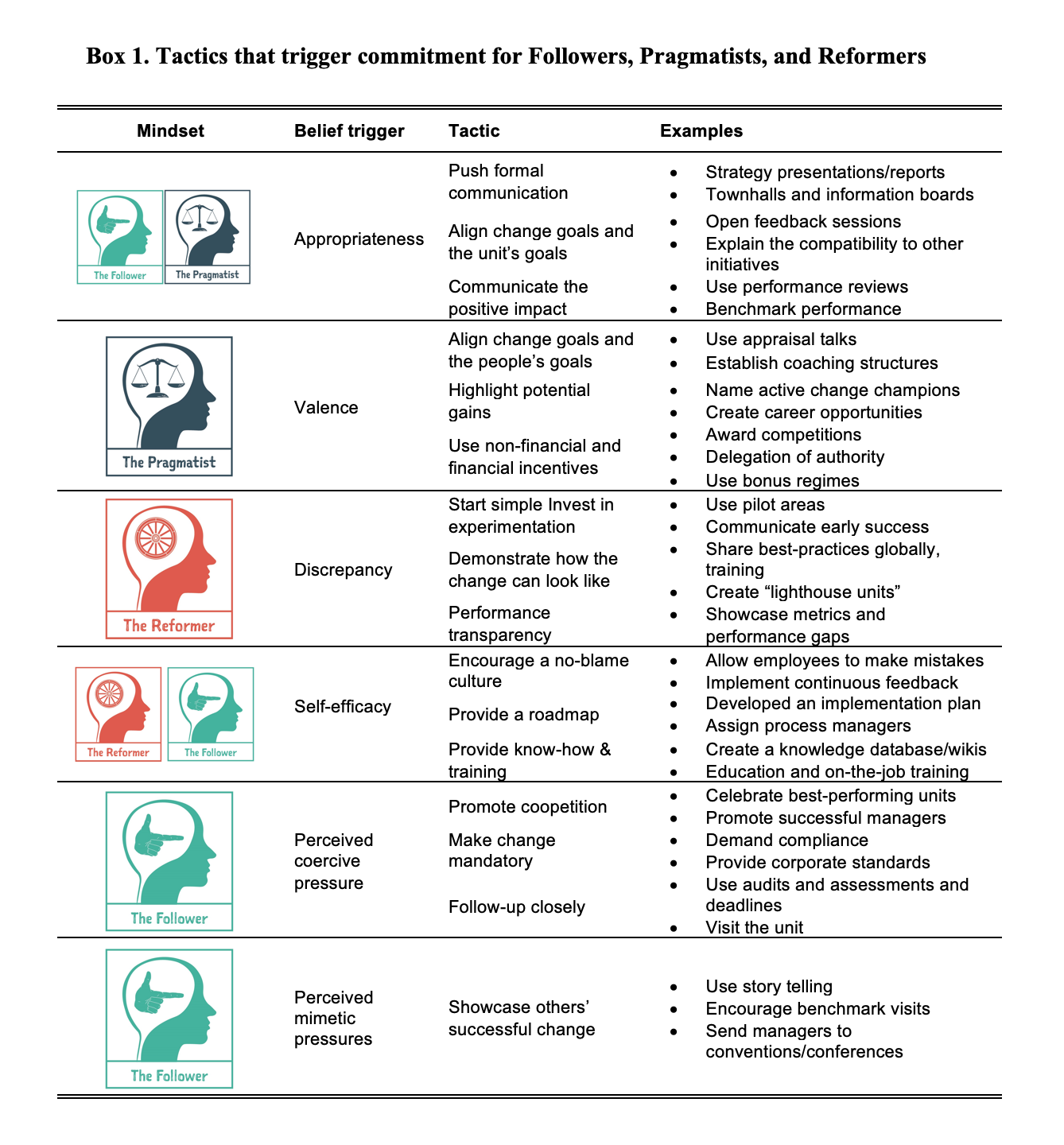California Management Review
California Management Review is a premier academic management journal published at UC Berkeley
by Torbjørn Netland, Maricela Arellano, and Johannes Meuer

Image Credit | Luis Villasmil
Corporate programs are challenging endeavors. Studies show that every two of three attempts fail—quality programs and lean transformations alike. Nor are the odds getting any better: a recent report by the Boston Consulting Group states that 70% of digital transformation programs fall short of their objectives1—and other studies report failure rates as high as 84%2. Why so bad? It isn’t because the benefits aren’t clear. Usually, the company intends to adopt business practices of more advanced firms, and stands to gain in productivity, growth, and profits3.
“Perfectly Confident Leadership” by Don A. Moore
“CSR Needs CPR: Corporate Sustainability and Politics” by Thomas P. Lyon, Magali A. Delmas, John W. Maxwell, Pratima (Tima) Bansal, Mireille Chiroleu-Assouline, Patricia Crifo, Rodolphe Durand, Jean-Pascal Gond, Andrew King, Michael Lenox, Michael Toffel, David Vogel, & Frank Wijen
Results from the World Management Survey, covering data from 12,000 managers, suggest that moving a firm from the bottom 10% to top 10% adopters of well-known management practices yields 25% faster annual growth and 75% higher productivity, and boosts innovation by a factor of ten4. The means are also usually apparent, whether the change involves swapping out software or reorganizing processes. In fact, the majority of change plans require neither rocket science nor sorcery. And given that most changes are incremental, the work itself is often relatively simple.
So, what goes wrong? A plethora of research has sought to better understand why corporate change programs fail. Early research on planned change advanced a structural perspective while more recent research emphasizes a behavioral perspective5. Both streams argue that the biggest difference between change that succeeds and change that fails is the strength of managers’ commitment to it. This insight—despite being reported so often—hasn’t been very helpful as it doesn’t tell us anything about why so many managers stay disengaged from important programs. To find out, we investigated what committed managers think about the new practices they are driving.
Our research studied the cognitive foundations of commitment to practice adoption in multinational firms (for details, see our article “Commitment follows beliefs: A configurational perspective on operations managers’ commitment to practice adoption” recently published in the Journal of Operations Management6). We conducted in-depth surveys with 76 unit-level senior managers who had recently implemented such a change in their organizations successfully, asking about their beliefs and commitments to the change. To analyze our rich dataset, we use qualitative comparative analysis (QCA), which is able to handle equifinality—the idea that several paths can lead to the same outcome.
We found that managerial commitment depended not on one kind of belief about the change and their own role in making it happen, but on specific combinations of three known belief types7:
Managers who pursue programs with strong commitment mix these types of beliefs into three basic mindsets (see Exhibit 1). Although the cognitive paths that leads to these mindsets differ, they all result in commitment to change.

Exhibit 1. Three belief configurations that lead to high commitment to change
To illustrate each of the belief configurations, we draw on data collected first-hand from a case study of a corporate lean transformation in a global chemical company. To keep the examples focused, we select expressive quotes related to implementing one of the most significant practices in the planned transformation: daily shop-floor meetings around production status boards (also known as daily “huddles”). This change was mandated by the headquarters for implementation across all 40 sites of the company, located on all continents. The case serves as a useful setting for studying belief configurations because it entails both structural and behavioral change and involves everyone in the local sites.
The Follower is primarily motivated by external pressures—especially those coming from further up the ladder (i.e., coercive pressures) but also from what peers do (i.e., mimetic pressures) but still has a lot of confidence in his or her own abilities (i.e., self-efficacy). The Follower is unafraid of making a change and will fight for its adoption if it seems likely to make the team improve and look better (i.e., appropriateness). An example of a Follower is a senior manager we interviewed who implemented the mandated boards and expressed beliefs that benefits will eventually be tangible and that he could drive it:
“This is modern production best practice [coercive and mimetic pressures]. We have come a short way in our journey (…) but the benefits will undoubtedly come [appropriateness]. The working environment is changing visibly, and attitudes are changing too [self-efficacy]. I have little doubt that all this work will pay off in the long term.” Factory Manager & Follower
Making Followers commit to change is straightforward; a clear mandate and strategic direction will go a long way as long as there is clear communication about the effectiveness of the proposed change.
The Pragmatist commits when he or she sees the possibilities of gains for the team (i.e., appropriateness) and him or herself (i.e., valence) but is not particularly motivated by a perceived need to close a gap (i.e., absence of discrepancy). A factory manager we interviewed captured the quintessence of the Pragmatist:
“The new corporate boards required us to get rid of the old. But this is no problem; we can place our old figure on our new boards. This way, we achieve renewed visibility and support for my strategy [valence] and can boost performance further [appropriateness].” Factory Manager & Pragmatist
A command is not likely to be enough for the Pragmatist. Rather, the Pragmatist can be nudged into commitment when the purpose and gains of the change for both the organization and him or herself are made explicit. For example, measuring implementation and creating competitions with awards attract the Pragmatist to commit to a new practice.
The Reformer is positive about his or her own abilities to drive the change (i.e., self-efficacy). But different from the Follower, she or he sees the need for change most clearly, perceiving a gap between current practice and the future being proposed (i.e., discrepancy). We encountered an example of a Reformer in a factory that implemented the planned change immediately when it was announced—but distinctively different from the corporate template:
“Improvement with or without [the corporate board template] is honestly the same. We would have done it anyway [discrepancy]. We come up with a project idea and work it out [self-efficacy].” Operations Manager & Reformer
A Reformer is less impressed by mandates and orders. To commit a Reformer, provide him or her resources and autonomy to implement the change in the way he or she feels is best. You can nudge Reformers to commit by showing them ideas and successes from other sites and companies but shouldn’t call them out if they make missteps early on.
For a strategist responsible for driving change through an organization, the important thing to keep in mind is that any one of the three configurations makes the cut. Leaders come in different shapes and are constantly navigating uneasy waters, so don’t make the false assumption that everyone will be motivated in the same way8. As a leader of leaders, you need to inspire one of the three combinations of beliefs in each of your subordinates to trigger a strong commitment to the change.
How should you do it? Based on what we learned, we have four general suggestions for corporate managers:
Henry Ford once said, “Think you can, think you can’t; either way you’ll be right.” Change management is an intensely human activity. Anthropologists concluded long ago that human beings are hard-wired to trade and cooperate. This insight still holds for planned change programs. Leaders trade-off benefits to perceived costs in their minds. While leaders are weighting factors differently, they all commit if the sum is positive
Even in an era of rapidly advancing artificial intelligence and data analytics, our research suggests that there is no getting away from the need to make sure people believe in the value of their projects. The killer app of change management is still beliefs.
1. Forth, P., T. Reichert, R. de Laubier, and S. Chakraborty (2020). Flipping the Odds of Digital Transformation Success. Boston Consulting Group, Oct. 29, 2020, www.bcg.com.
2. Rogers, B. (2016). Why 84% of Companies Fail at Digital Transformation, Forbes, Jan. 7, www.forbes.com.
3. Netland, T. and K. Ferdows (2014). What to Expect from a Corporate Lean Program, MIT Sloan Management Review 55(3), 83-89.
4. Sadun, R., N. Bloom, and J.v. Reenen (2017). Why do We Undervalue Competent Management? Neither Great Leadership Nor Brilliant Strategy Matters Without Operational Excellence. Harvard Business Review 95(5) 120-127.
5. Stouten, J., D.M. Rousseau, and D. De Cremer (2018). Successful organizational change: Integrating the management practice and scholarly literatures. Academy of Management Annals 12(2), 752-788
6. Arellano, M.C., J. Meuer, and T, Netland (2021). Commitment follows Beliefs: A Configurational Perspective on Operations Managers’ Commitment to Practice Adoption. Journal of Operations Management 67(4), 450-475.
7. Ajzen, I. (1991). The Theory of Planned Behavior. Organizational Behavior and Human Decision Processes 50(2), 179-211.
8. Solberg, E., Traavik, L.E.M., Wong, S.I., (2020). Digital mindsets: Recognizing and leveraging individual beliefs for digital transformation. California Management Review 62(4), 105-124.
9. Sinek, S. (2009) Start with why: How great leaders inspire everyone to take action. Penguin
Box 1. Tactics that trigger commitment for Followers, Pragmatists, and Reformers
